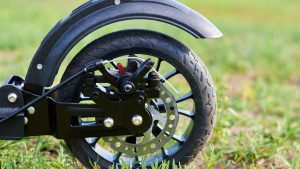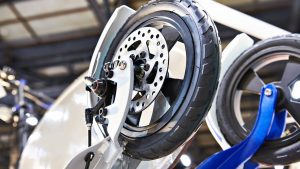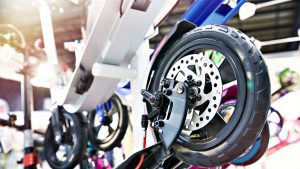When it comes to scooter maintenance, one aspect we can’t overlook is the brake pads. These little wonders help us slow down or come to a complete stop when needed – crucial for our safety on the road! But like all parts, they wear out and need replacement over time. So, how do we know when it’s time to change them and how do we go about doing it?

At FamilyHype, we understand the importance of scooter safety, so we’re here to walk you through the signs that your electric brake pads need attention and provide you with a step-by-step test to ensure your scooter brake system is working optimally, explain when to change them, and list the tools you’ll need for the job. We’ll also guide you step-by-step on how to tackle this task yourself. Lastly, we’ll share some maintenance tips to extend their lifespan.
To begin, it’s important to note that this content is not for gas powered scooters. Electric scooters, mopeds, and motorcycles all have different brake pads and will require different maintenance techniques.
When it comes to brake pads, one of the most common signs that they need to be replaced is when you hear a squealing or grinding noise when you apply the brakes. This is an indication that the pad has worn down and needs to be replaced as soon as possible. Additionally, if the brake lever is feeling spongy or soft when you press down on it, it may be because the pads have worn down and need to be replaced.
Replacing the electric brakes pads is a relatively simple task, but it does require some basic tools such as a wrench and other accessories, a socket set, and a pair of pliers. Additionally, you’ll need to buy a new set of brake pads that are compatible with your scooter. Once you have all the necessary tools, you’ll need to begin by removing the old brake pads and then installing the new ones. It’s important to follow the instructions closely in order to ensure that the brake pads are installed correctly.
Once the new brake pads are installed, it’s important to check that they are functioning properly. You can do this by pressing the brake lever and listening for any squealing or grinding noises. If this is the case, then you’ll need to go back and make sure that the brake pads are correctly installed.
Finally, to extend the life of your brake pads, it’s important to keep them clean and lubricated. This can be done by regularly wiping them down with a clean cloth and making sure that any dirt or debris is removed. Additionally, it’s important to occasionally lubricate the brake pads to ensure that they are functioning properly.
By following these steps, you’ll be able to ensure that your scooter’s electric scooter brake pads are functioning properly and that you know when to change brake components for optimal safety and that you and your family are safe while riding. At FamilyHype, we understand the importance of keeping scooters safe and sound for our rides, as well as those of others around us! So, if you have any questions or feedback about scooter brake pads, please don’t hesitate to reach out!
Key Takeaways
At FamilyHype, we understand the importance of safety when it comes to scooters, and how crucial brake pads are for the safety of scooters. Knowing when to replace them, recognizing the signs of wear, and understanding the replacement process are essential to ensure the brakes always perform at their best and extend their life.
In this article, we will focus on the topic of electric scooters and when and how to change their brake pads. The primary element for this article is Vehicle Maintenance with entities such as Safety, Brake Pads, Wear, Performance, and Replacement. Safety is of the utmost importance when it comes to electric scooters and their brake pads. Brake pads are key components of electric scooters as they help reduce stopping distance and prevent accidents. Wear can include noise and decreased braking power. Performance is improved when brake pads are replaced. Replacement should be done when the brake pads show signs of wear or after a certain number of miles.
When it comes to replacing the brake pads, it’s important to remember the overall focus of the article is about electric scooters. Be sure to use the right tools for the job and follow the manufacturer’s instructions. At FamilyHype, we believe in the power of the family unit and we want to help keep your electric scooter safe to enjoy every ride!

Understanding The Importance Of Brake Pads
Understanding the importance of brake pads for electric scooters can be a matter of life and death. So, it’s important to take the time to select the optimal pad material for your scooter, reflecting your commitment to keeping roads safe for everyone.
Maintaining the brakes on your scooter is crucial for ensuring your safety while riding. Regularly replacing Scooter brake pads is essential to keep your brakes in optimal working condition. Brake pads are a vital component that needs attention, and knowing when and how to replace them can greatly enhance your riding experience.
When it’s time to change brake pads on your scooter and ensure the safety of your braking system, it’s essential to understand the details of the process. Depending on the size and condition of your scooter’s brake pads, the replacement procedure may vary. Begin by searching for videos or step-by-step guides that demonstrate how to remove and change brake pads. These resources can provide valuable insights and help you tackle the task confidently.
Here at FamilyHype, we value the family unit and safety, so it’s important to recognize when these crucial components require replacement. The main point related to this topic is ‘Vehicle Maintenance’, with 3 new entities – brake pads, pad material selection, and road safety.
All of these are essential for understanding and preserving the lifeline of your scooter – its brake pads – and promoting safety.
We hope this article has been helpful in understanding the importance of brake pads.
Signs Your Friction Pads Needs Replacement
For electric scooter owners, observing certain indications such as a decrease in braking efficiency, hearing unusual sounds, or having difficulty stopping, could suggest that it’s time to replace the brake pads.
The state of your brake pads has a direct impact on your scooter’s stopping distance, so it’s important to stay vigilant and investigate further if you notice any changes.
Here at FamilyHype, our writers and editors, who’re either parents or those highly valuing the family unit, understand the importance of properly functioning scooter brakes. That’s why we recommend familiarizing yourself with these main terms such as brake pads, as well as their attributes and values, to ensure your brakes are in optimal condition.
From the materials used to the type of pad to the timing of replacement, it’s essential to be aware of the different components and how they affect your scooter.
When To Replace Your Friction Pads?
Knowing when to replace your brake pads for your scooter can be a bit tricky, but there are certain signs and symptoms that shouldn’t be ignored. The cost of brake pads shouldn’t deter us from prioritizing safety. Remember, your riding habits impact how often you’ll need replacements. So keep an eye out and listen for any changes in braking performance.
As you embark on the brake pad replacement journey, you have options to choose from. Quality is key when it comes to brake pads, as they play a critical role in your scooter’s performance and safety. Consider choosing brake pads that protect your scooter’s braking system and offer enhanced stopping power. While the price might vary based on the product and brand, prioritizing quality is essential for your peace of mind on the road.
Before diving into the replacement process, take some time to clean the brakes and understand the condition of your current brake pads. Based on the wear and scraping you might notice, you can determine the urgency of the replacement. It’s also a good opportunity to check for any other maintenance needs your scooter might have.
It’s important to consider the type of scooter you’re riding, the material it’s made out of, the brake pad material, the amount of friction the pads will create, and the size and weight of the scooter when determining when it’s time to replace your brake pads.
At FamilyHype, our writers and editors are either parents or people who highly value the family unit. That’s why we want to emphasize the importance of safety when it comes to scooters and replacing brake pads.
When replacing brake pads, you’ll need a few essential tools. Make sure you have a set of wrenches, screwdrivers, and a jack to properly lift and secure the scooter. You’ll also need the replacement pads, which come in a variety of materials, sizes, and shapes, depending on the type of scooter you’re riding. Additionally, you’ll need a replacement pad holder and a brake pad spreader to make sure the pads are properly installed.
By following these steps, you can ensure your scooter is properly taken care of and that your brake pads are replaced when necessary. This will help keep you and your family safe on the roads while riding your scooter.
Tools Needed For Friction Lining Replacement
Let’s delve into the nitty-gritty of scooter maintenance and repair: the essential toolkit you’ll need to ensure a smooth and successful brake pad change. If you’re looking for a guide on brake pad replacement for your gas-powered scooter, you’ve come to the right place. Here at FamilyHype, we’re devoted to helping families search for the best scooter experiences.
To replace the brake pads, carefully follow the instructions provided in the videos or guides you found. Take into account the size and type of brake pads your scooter requires. Reading the product details and understanding how the replacement process works will help you ensure a successful outcome.
Before making a decision, take some time to read about the various options available, as you consider whether it’s time for a change, weighing the potential changes needed, and conducting a thorough search to compare prices and find the best price for your needs.
To get started, you’ll need the following items: a set of screwdrivers for removing the caliper bolts, quality brake pad materials to promote longevity and better braking performance, and Tool Selection Tips to help you pick suitable tools.
Step-By-Step Guide To Replacing Friction Pads
Ready to dive into the mechanics of it all? Here’s a step-by-step guide to help you switch out those worn-out brake components with ease and confidence.
First, understand your brake pad materials as they impact the pad replacement cost. Different scooter brake pads can come in materials such as metal, carbon fiber, rubber, or ceramic, each with their own unique benefits and drawbacks.
Next, carefully remove the brake old pads, install new ones, and ensure a secure fitment for your braking system. With these actions done selflessly, you’re also serving your ride well!
Now let’s move on to some maintenance tips for extending the life of your newly installed brake pads. To ensure maximum safety and efficiency, it’s important to regularly check the condition of your scooter brakes. Clean the brake pads and rotors, check for wear and tear, and adjust the brake pad height.
Lastly, make sure to use the right brake fluid and lubricants for your scooter. By following these tips, you can trust that your scooter and its brakes will be in great condition for years to come.
At FamilyHype, we understand the importance of having a reliable and safe ride. That’s why we’ve put together this comprehensive guide to replacing brake pads, so you can enjoy your scooter without worry. We hope this guide has been helpful, and we’d love to hear your feedback.

Maintenance Tips To Extend The Life Of Brake Pads
Scooter riders, if you’ve installed new brake pads on your ride and want them to last as long as possible, FamilyHype’s got you covered! As a website dedicated to helping families, we understand the importance of extending the life of your brake pads. Here are a few maintenance tips to help you do just that:
- Adopt proper Pad Cleaning Techniques to remove dirt and grime. This could include wiping down the pads with a damp cloth or using a degreaser to remove built-up grease and grime.
- Regular Lubricant Usage helps reduce friction and wear. This includes regularly greasing the brake caliper pins and the wheel hub.
- Avoid unnecessary hard stops; they decrease the lifespan of your pads. Slowing down gradually can help preserve the brakes and extend the life of your pads.
These tips can help you extend the life of your scooter’s brake pads, and with the proper care and maintenance, you can ensure that your scooter will remain in top condition for many years to come. We hope these tips will help you get the most out of your scooter and keep you and your family safe.
Conclusion
At FamilyHype, we understand how crucial brake pads are for the safety of scooters. Knowing when to replace them, recognizing the signs of wear, and understanding the replacement process is essential to ensure the brakes always perform at their best and extend their life.
Ultimately, replacing your scooter’s brake pads is an essential aspect of maintenance that should never be overlooked. By choosing quality brake pads based on your scooter’s specifications and condition, you’re making a valuable investment in your safety. Regularly checking your brake pads and understanding the process of replacement will keep your scooter in excellent working condition, ensuring a smooth and secure riding experience every time you hit the road.
In this article, we will focus on the topic of scooters and when and how to replace their brake pads.
The primary point of this article is Vehicle Maintenance with entities such as Safety, Brake Pads, and Replacement. Safety is of the utmost importance when it comes to scooters and their brake pads. Brake pads are key components of scooters as they help reduce stopping distance and prevent accidents. Replacement should be done when the brake pads show signs of wear, such as noise and decreased braking power, or after a certain number of miles.
When it comes to replacing the brake pads, it’s important to remember the overall focus of the article is about scooters. Be sure to use the right tools for the job and follow the manufacturer’s instructions.
Frequently Asked Questions (FAQs):
How Long Do Brake Pads Last?
Brake pads on a scooter can last between 5,000 to 10,000 kilometers (3,000 to 6,000 miles) on average, but this can vary depending on riding conditions and habits.
How Do I Know I Need New Brake Pads?
You might need new brake pads if you hear squealing or squeaking noises when braking, experience reduced braking performance, notice vibrations while braking, or if the pads are less than around 2-3mm thick.
At What Should Brake Pads Be Replaced?
Brake pads should be replaced when they are worn down to around 2-3mm in thickness or when you observe signs of wear and decreased braking efficiency.
How Do You Check Friction Pads?
To check the brake pads on a scooter, inspect them through the caliper openings or remove the caliper if necessary. Look for visible thickness and signs of excessive wear or damage.
How Do I Know When My Motorcycle Friction Pads Need Updating?
You’ll know your motorcycle brake pads need replacing if you experience reduced braking performance, hear unusual noises while braking, feel vibrations in the brake lever or pedal, or if the pads are significantly worn down.
Which Friction Pads Is Better?
Both disc brakes and drum brakes are commonly used on scooters. Disc brakes offer better stopping power and responsiveness, while drum brakes are simpler and more cost-effective.
When Should I Change My Scooter Brake Shoes?
Scooter brake shoes should be replaced when they are significantly worn down, which typically occurs between 10,000 to 20,000 kilometers (6,000 to 12,000 miles).
How Do I Know If My Motorcycle Brakes Are Bad?
You can tell if your motorcycle brakes are bad if you experience decreased braking performance, hear strange noises while braking, feel vibrations in the brake lever or pedal, or notice difficulty in stopping.
How Long Should Friction Pads Last Km?
Brake pads on a scooter typically last between 5,000 to 10,000 kilometers (3,000 to 6,000 miles) on average.
Can Friction Pads Last 5 Years?
The lifespan of brake pads can vary depending on usage and riding conditions, but it is possible for them to last up to 5 years with moderate use and proper maintenance. However, it’s essential to monitor their condition regularly and replace them when needed for safety reasons.
